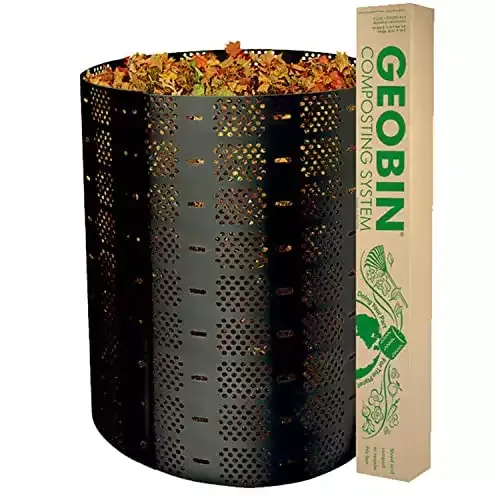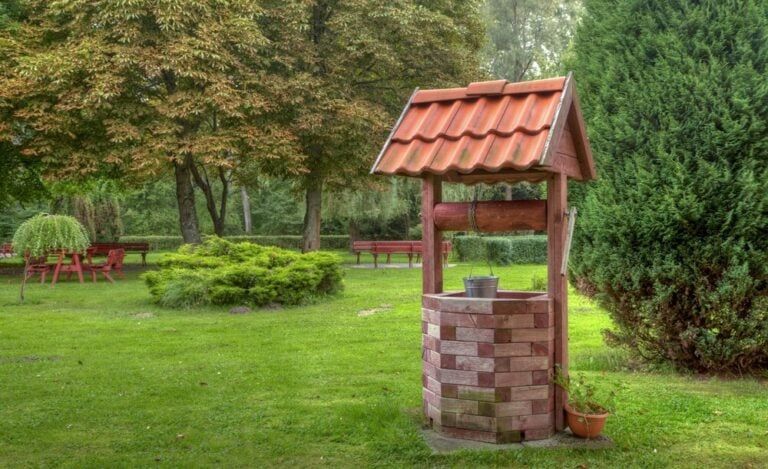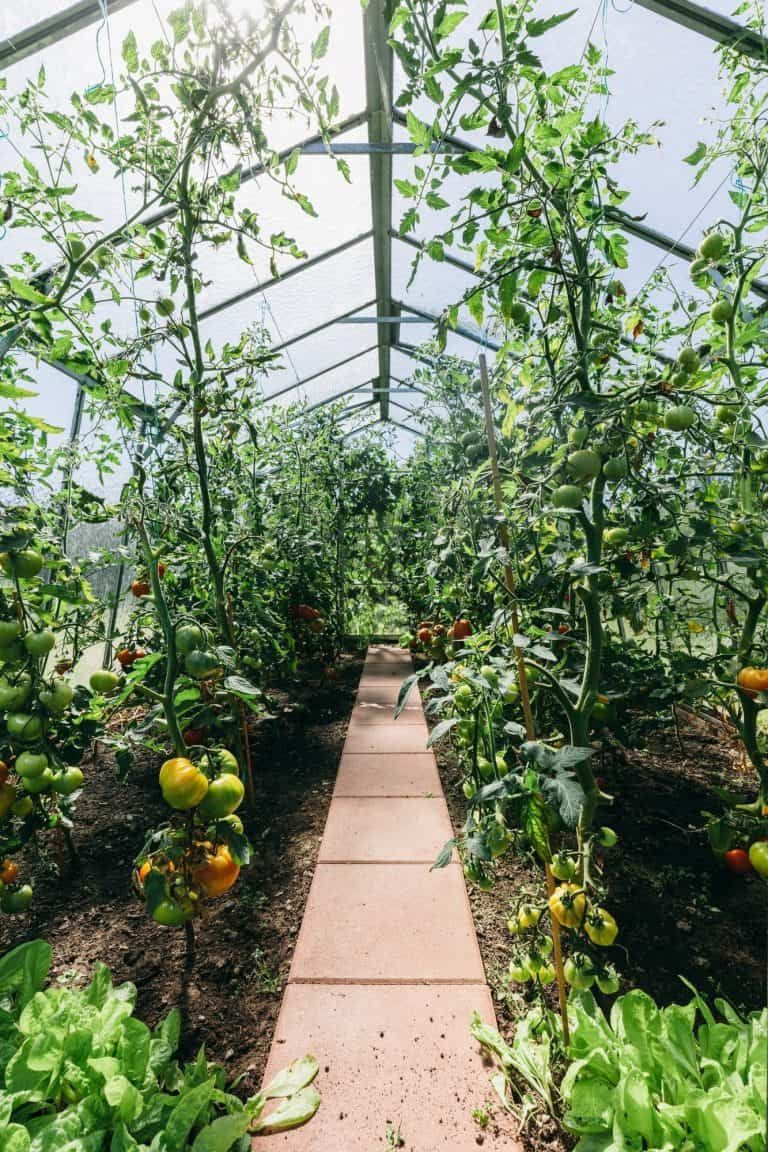The Best Compost Bin Only Costs About $40
Welcome! This article contains affiliate links, meaning I get a commission if you decide to make a purchase through my links, at no extra cost to you.
I was recently asked what my best compost bin is. You might imagine it’d be some super fancy turning compost bin or compost tumbler, but it’s not. My favorite way to compost is actually to just throw it all on a heap. However, there are places where I don’t want a heap and that’s where the Geobin comes in. It’s expandable, cheap, and works beautifully.
Here’s my Geobin review.
Geobin – The Best Compost Bin for the Money
My favorite compost bin is the Geobin. Having a large garden, I need a good-sized compost bin to do the job. Most compost bins, including tumblers, are too small to compost in bulk. You’ll get a bit of compost, but you’ll need multiple bins, which skyrockets the purchase price.
Looks like this Geobin compost bin is not just my best compost bin – it has 872 reviews on Amazon, 4.4 out of 5!
I’ll list some pros and cons below.
How Much Compost Can You Make
The Geobin is made in the US and it’s super simple to set up. It’s expandable, so you can leave it at its smallest diameter of 2 feet or expand it to its full 3.75 feet, which holds 216 gallons of composting material.
That’s much better than, for example, the super-popular Envirocycle tumbler which holds 35 gallons at most. It may be the “cutest composter” out there, but it also costs around $190! Gulp.
How to Put the Geobin Together
The Geobin is a very simple design, it won’t give you much trouble putting it together. It’s made of a flexible plastic, which is held together by keys. That makes it expandable too.
It can be a bit floppy when it’s empty, but once you have a few inches of compost in the bottom, it becomes really quite stable. If it’s bothering you, or you’re worried about storms etc., some people use garden stakes to stake the bin in place. A couple of 4ft stakes should do the trick.
How Do You Get the Compost Out?
There are a few options for getting the finished compost out of the Geobin.
- Remove the lowest closure keys so you can open up the Geobin. Shovel out the amount of compost that’s ready.
- Transfer the unused part into another Geobin and use the finished compost underneath. This is a great way of turning your compost to.
- If you don’t want to buy another Geobin, slide your existing one up off the compost. Put it next to the pile. Put the unfinished compost back into the Geobin. That leaves you with a pile of finished, usable compost.
Geobin Pros
- Geobin support is excellent. Many people reported losing the keys that hold the outer mesh together, and being sent a free set after contacting the seller.
- Large capacity.
- Easy and no-fuss
- Easy to move to a different location.
- Cheap!
Geobin Cons
- It doesn’t look as fancy as some of the “cuter” compost bins out there.
- It feels a bit unstable when it’s empty. Some people mentioned that it can tip in windy weather or if the balance isn’t quite right.
- Does not keep animals out. If you have issues with animals getting into your compost, you might want to look at a closed compost bin.
- Some people had trouble putting it together. You need to make a circle with the stiff plastic and some people reported they needed two people to get it together. I have found it extremely easy to put together, but just something to keep in mind.
Geobin Reviews
“This was the easiest compost bin I have ever used and I could use it by myself with no help. Very easy to put together with the keys. And when I take it apart to turn it I just pull it and the keys pop off. The compost stays in place and it makes it easy for me to be able to turn it by myself.”
“I was up and running in literally 5 minutes. The setup was super simple. The material is very durable.”
“Tip – Geobin: Place one or two 4 foot rebar(s), minimum of 1/2 inch, within the Geobin pile to aid with aeration in the center. 1/2 is easier to find, if you have 3/4 it’s much better. Place your rebar in the pile before building up for easier use. Every few weeks, when no frost, I give a couple of cranks to introduce air.”
“This bin is a great value. It’s simple, cheap, and it works. Frankly, it does not make much sense to spend over a hundred dollars for a bin, which is what most cost.”
Convinced? You can buy the Geobin here:
How to Compost
The trick to composting is to use plenty of brown material. It’s harder than you think to find enough brown material to add to your compost, as you’ll generally have plenty of grass clippings and kitchen scraps, but not as much straw, dead leaves, or hay, for example.
Read more: The Completely Guide to Composting for Surprising Simple Super Soil
Other brown materials include dead plants and weeds, small twigs and branches, and sawdust. Without brown materials, your compost will be a soggy, stinking mess. Browns add air to your compost, which allows an “aerobic” composting environment (with air).
This is opposite to “anaerobic” (without air). Anaerobic compost can still work, but they often smell, take longer to compost, and don’t generate heat. Compost that doesn’t generate heat won’t kill weeds and bad pathogens/diseases. Aim for at least ⅓ brown materials.
Green materials include green leaves, weeds, flowers, and kitchen scraps. Greens are high in nitrogen, so they activate the heating process. Combined with the browns, you’ll have a rocket of a compost heap, ready in as little as 8 weeks.
The last tip is to keep it moist. Not soaking wet, but moist. Once it starts heating up, you’ll find it keeps itself wet, but until then, give it a sprinkle of water when it feels dry. Turning speeds up the process greatly but does involve effort. It’s best to turn it every 4-6 weeks. If you consider your compost could be ready in 2 months, that’s only once.
What type of compost bin do you use? What the best compost bin you recommend?



![When to Pick Zucchini for the Perfect Harvest [Tasty + Tender!]](https://69be7209.flyingcdn.com/wp-content/uploads/2022/11/yummy-looking-zucchini-and-fresh-garden-vegetables-768x511.jpg)
![17 Best Herb and Herbalism Courses and Books for Beginners [and Pros!]](https://69be7209.flyingcdn.com/wp-content/uploads/2022/06/best-herb-herbalism-courses-and-books-768x598.jpg)



I quite like the geobin. I have two of them. When I lost a key, I used a zip tie, which I actually found much easier than the keys, so now I use all zip ties.
Hi Sara! Oh, I love zip ties – aren’t they just the handiest thing ever?! Great tip – thank you very much 🙂
Hi, Elle. I have a great way to improve the Geobin. Is there a way I can post a photograph here?
Rob
Sure Rob, sounds great! You should be able to attach an image to your comment not that I’ve approved it. Looking forward to seeing it!
Hi Elle, thank you for the go-ahead. See three versions of my idea. From left to right:
1. Geobin strapped to a 10’ long, 1/2” electrical conduit formed into a hoop with a tubing roller.
2. Presto Hoop Bin (Geobin predecessor) strapped to a 30” diameter hula hoop.
3. PHB strapped to a 27” bicycle rim.
The folks at Geobin poo-pooed my idea, saying the adjustability feature needed to be available, and that some people like egg shaped bins. I think they are nuts and they don’t even use their own product onsite to show off how well it works, which leads me to believe they just want to sell recycled plastic.
What do you think about the GeoHoopBin?
Hey Rob, my apologies for the delay!
Thanks for sharing your photo, I think your bins look cool!
I’m sure some people would want the adjustable feature, but for people who prefer a more rigid bin (which could be easier to deal with when you’re turning composts etc.), this could be great 🙂